
Designing and
Building the 1970s PULSE set
By Mike Clark

|
The 1970’s PULSE set graced Channel 13’s airways with classic lines that were visually pleasing but also very practical for television broadcasting. The PULSE set was the first television effort of its designer and builder, Herb Schmoll. |
Herb Schmoll graduated as a Theater Major from the Art Institute of Chicago, Goodman Theatre, in 1970..He worked briefly at The Showboat Dinner Theater in Clearwater and then went into business for himself by opening Design Forum, a firm that carried theatrical equipment and supplies including lighting, fabrics and paint. Design Forum was situated on Dale Mabry, not far from Channel 13's Kennedy Blvd. studios. Herb soon became acquainted with WTVT production manager Dan Boger, who bought several gallons of blue Chroma Key paint.
Schmoll's first TV client was Ch. 13's Dan Boger
Boger was back in touch with Herb shortly after their initial transaction. Would Herb be willing to submit an original proposal for a PULSE news set? Quoting market research, Boger explained that the evolving format of local television news dictated that banter between the anchors was something the viewers would like to see more of and WTVT was happy to deliver this arrangement. The new set would make it possible for the anchors to interact directly with each other, something not easily done in previous years with the departments scattered around the station. Boger added that the proposal was “hush hush” so that rival broadcasters at Channels 8 and 10 would not hear about WTVT's plans.
The tantalizing nature of the request piqued Herb’s interest and he joined Boger for a look at the current setup in WTVT's Kennedy Blvd. studios.
Herb was shown the narrow but long Studio A (“I’ve been in places with larger men’s rooms”). The plan was for news, sports and weather to all be housed in Studio A's limited space. Since 1966, PULSE news was anchored from the Color Communications Center in the newsroom adjacent the larger Studio B, while Sports was sometimes located in Studio A or B. Roy Leep's weather set had long been residing in Studio A due to the cabling that connected the area to the station's radar and weather reporting equipment outside. Whatever Herb would plan, this meant that the weather set had to remain where it was.
|
|
|
|
|
The Color Communications Center was used from 1966-70 |
Chip Collins sits adjacent blue
screen |
Roy Leep's weather set was permanently situated in the south corner of Studio A. |
Although Herb had no experience in TV, he was young, full of courage, and accepted the challenge of designing the new PULSE set.
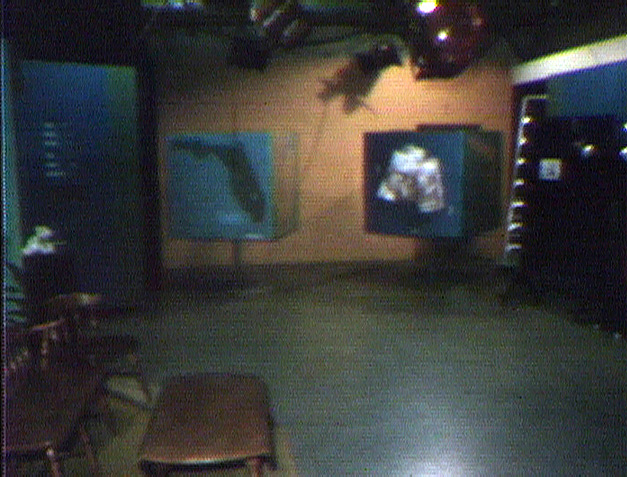
The Weather set soon to get a makeover. Towards the left is part of the
sports set.
For the next few days Herb watched from the control room and floor as PULSE was broadcast to gain a sense of the newscast and movements of the crew. He began a series of interviews with the department heads of news, sports, and weather to gather their input for his design. “Salty Sol” Fleischman was especially excited about the idea and contributed the concept of the interview section that separated the news and sports anchors.
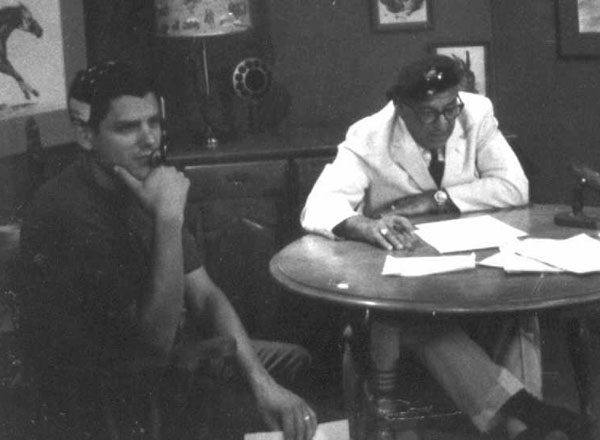 |
 |
|
Floor Director Jim Benedict with Salty Sol Fleischman on the sports set (1966) |
Andy Hardy and wrestler Gene Kinski (1970) |
Studio A’s long but narrow dimensions would limit the number of angles possible in the new design. With a distance of only 22 feet from the control room window to the back wall (and even less when the camera and operator were in place), the head-on view of the anchors would have to be designed within the tight space. A wide-angle shot of the entire set could only be accomplished by placing the camera into the far northwest corner of Studio A; any design Herb conceived would have to take that into consideration.
The most challenging part of the set was Roy Leep’s weather area. Roy needed a built-in space for his radar monitor and controls, a display area for weather maps and satellite pictures, and a wall containing six panels for the current temperature & humidity displays, live wind gauges and real-time pollution monitor. Roy was specific in his desire to use rotating numbers on the current temperature and forecast boards that could be updated immediately prior to the weathercast.
Dan Boger, director Paul Koenig and other production personnel spent time with Herb to give him some insights into television production. They discussed how certain hues are rendered on color television, the effect of lens focal lengths, how lighting would be done on the new set and how the use of long-neck miniature microphones would replace the clunky ‘50’s style desktop mics and lavaliers used up until then.
It was during this process that Herb visualized building the new set as a series of arcs since TV cameras rotate on a point in an arc-like manner. The set came together in Herb’s mind as three arcs: Arc 1 for Sports and the interview area. Arc 2 for the News anchor, and Arc 3 for Weather. The Sports and News anchor desks would have curved fronts to mimic the arcs and the entire construction would sit on a 6” riser to provide a level view of the anchors from the pedestal-mounted cameras.

Herb Schmoll's plan called for 3 arcs
fitting into the long but narrow WTVT Studio A

Newsman Ron Meyer with a Chroma Key background (1970).
Note "tearing" along Ron's head and jacket, a result of the RCA TK-42 color
cameras.
Due to the so-so quality of WTVT's first color cameras (RCA model TK-42), the blue-screen Chroma Key effect had been used sparingly in previous versions of the PULSE set. The station’s new General Electric PE-400 color cameras were capable of making excellent Chroma Key images and one of the main requests from Boger was that the news, sports and interview area be usable for Chroma Key.
Herb realized that a bare blue wall behind the anchors would be boring when the Chroma Key was not being utilized. Having learned that the Chroma Key would still work as long as the hues were within certain ranges, Herb thought of painting designs on the wall (such as the station’s BIG 13 logo) in various shades of blue. Then Herb remembered that a friend up in Gainesville had built his own vacuform machine for the construction of plastic displays that were dramatic and three dimensional. Herb figured that vacuforms would be an innovative way to add visual interest to the new set and allow the use of Chroma Key.

A vacuform is made when sheets of styrene plastic are heated to the melting point and placed over a wood pattern. The plastic is drawn by a vacuum process onto the pattern and assumes the pattern’s shape. The plastic is then cooled, removed, and another blank is put in its place. Multiple copies of a pattern are possible in this process. Herb designed and built a 3-D wood pattern incorporating the word PULSE and the 13 logo, which he used to make several examples in vacuform plastic.
|
|
Hugh Smith before and after the Chroma Key effect
With all his plans in place it was time for Herb to present the concepts to Channel 13’s management. Herb concedes that he is a better draftsman than rendering artist and hoped that the blueprints and the vacuform examples would sell his design. The PULSE set plans were first submitted to Dan Boger who was very impressed with the thought Herb had put into his proposal. With Boger’s approval and encouragement, he and Herb presented the final design to Ray Dantzler and all of the news, sports and weather department heads. Herb reviewed all of the requirements he had gathered during the interviews and demonstrated how they were addressed in the design. The meeting ended with an enthusiastic endorsement by all and a few days later Herb was awarded the job.
After a brief personal celebration Herb realized that now he had to BUILD the damn thing. His small Design Forum office was only 650 square feet-- big enough to build only the smaller pieces of the PULSE set. Channel 13 management then agreed to allow construction in Studio A but with a catch: Herb could only work after the 11pm PULSE news and before “A.M.” started around 5:30 the following morning. And it all had to happen in complete secrecy.
Boger arranged to move the sports set to studio B, leaving the non-weather portion of Studio A for set construction. Weather would remain in the south corner of Studio A until the last moment when Herb's new set would be installed. With no full time carpentry staff at Design Forum, Herb hired two student workers from USF’s theater department, swore them to secrecy, and began with the construction of the set’s platform, desks and curved wall. The background wall was composed of vertical struts covered with pliable doorskin wood to create a smooth curve. For all of the surfaces that were not to be covered by the vacuform panels, drywall cement was applied with a sponge for a textured stucco effect.
Once the curved walls were in place and dry, the application of over 100 PULSE vacuforms began. As mentioned before, the vacuforms would be painted Chroma Key blue, while the upper and lower wall sections were a muted off-white with subtle sparkle highlights. The platform would be covered with orange carpeting and topped by contemporary swivel interview chairs.

Sherry Taylor with Jacques and Phillipe Cousteau in the interview area
To make use of daytime hours, Herb built the news desks at Design Forum and prepped other parts of the construction there to speed work back at WTVT. News and Sports anchor desks were constructed of sturdy 1” plywood and fronted with styrofoam WTVT logos. Realizing that cameras might occasionally collide with and damage the styrofoam logos, Herb applied multiple coats of Elmer’s Glue to them for extra strength. Accidents did happen over the years leading to unsightly patches on the PULSE 13 logo.
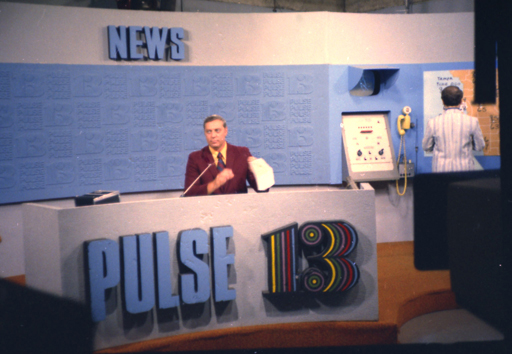
Over time the styrofoam letters
were nicked by studio pedestals
Herb's mother, already managing Design Forum's office and serving as a salesperson, kept the business humming while he was occupied with the PULSE set construction. After two week’s of exhausting nighttime work, the new set was taking shape but a final hurdle was fast approaching: installing the Weather section.
Herb had cleverly managed to
address the needs of Roy Leep’s area. The radar monitor was visible to the
weatherman through a TV-screen shape cut in the wall and shaded by a wooden hood. The bulky
radar controls were recessed behind the wall
with access below the monitor. The temperature/humidity forecast boards
were
made with plastic tumbler-style numbers (the kind used in gas station pumps of the
time) that were
secured on sturdy brass mountings. Herb was able to get the six laminated wood front pieces
turned out by a local cabinet maker. Directly to the left of the current
temperature/forecast board was a blank space for the display of satellite
photos. Herb's coup de grace for Roy’s weather set
was the creation of the ‘swinging doors’ weather map
section. In Roy's prior set, two rotating cubes used to display
temperatures and satellite photos took up 30 cubic
feet of studio space, whereas the the 'swinging doors' made more efficient use
of space and allowed the weathermen to change maps up to three
times in a simple, quiet manner (this often
occurred off-camera).
Disposable color paper maps
were printed and stored behind the set which included a preparation area and
access to a time lapse 16mm film camera for recording weather images off a
secondary radar monitor.
 |
|
|
Roy Leep's new weather set. Note radar controls at left under TV monitor hood, hinged weather maps at the center and various gauges at right |
Roy Leep could quietly change the maps on-air while during satellite photos |
Work on the new PULSE set came to a conclusion with only one incident: A partially finished riser on the old weather set resulted in one of Leep's meteorologists taking an on-air tumble one night and almost knocking himself unconscious.
With the work done it was time to shut down the old Color Communications Center and make the move to Studio A. The dynamic new set was a thrill to behold. The overall effect that Herb achieved was to have a functional, modern set that did not distract from the anchors and interviews. There's no doubt he succeeded.

It was a proud moment for Herb when the new PULSE set was received with positive reviews from management, crew, and viewers. It was also the topic of much discussion at the other stations as well.
Herb's total invoice for the new PULSE set: $2,000. Not bad, eh? If you figure the set served WTVT from 1971 to 1980...the amortization came out to a few pennies per use.
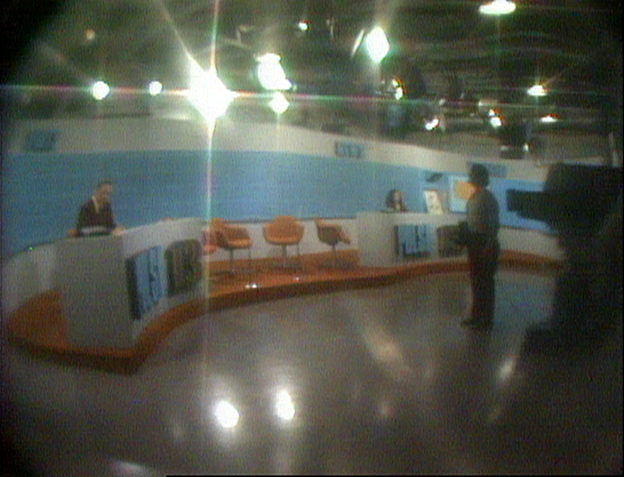 |
 |
TO ACHIEVE A WIDE ANGLE SHOT OF THE ENTIRE
SET, CAMERA 1 WAS PLACED IN THE CORNER OF STUDIO A AND EQUIPPED WITH A
PLASTIC LENS
THAT WIDENED THE VIEW AND PROVIDED OPTICAL DISTORTION. THE
PULSE BANNER WAS ADDED IN THE CONTROL ROOM
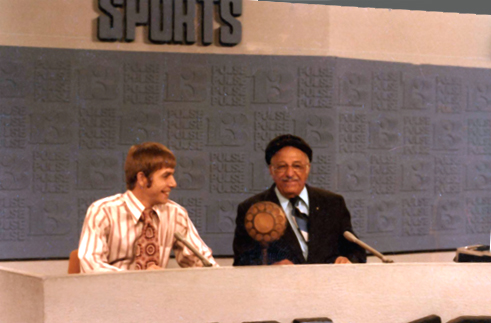
ANDY HARDY AND 'SALTY SOL' ENJOY THEIR NEW
DIGS

A unique angle from Andy Hardy's point-of-view. Note streamlined Sony
ECM-51
microphones,
desktop monitor and ashtray!
The PULSE set served daily for the next few years until 1976, when some decisions made without Herb’s input departed from his original concept.
THINGS ARE GETTING A LITTLE CROWDED ON PULSE.
Anchor Ray Blush is seen at right.
After five years of use, WTVT management felt that the anchors should be even closer and moved the sports desk adjacent to news. The 'double vision' effect was a little unsettling but not as much as what followed.

Lesley Spencer anchors Pulse Plus! while floorman Joe Puleo is
stunned by the Pulse set's new color combination.
In 1977 the two anchor desks were were covered with a bonding material to make one long desk which was painted brown. A yellow styrofoam PULSE logo was placed on the front and the back wall borders were also painted yellow. This unfortunate color combo lasted a couple of years before a more dignified wooden desk was brought in and the yellow border above and below the vacuforms was muted.
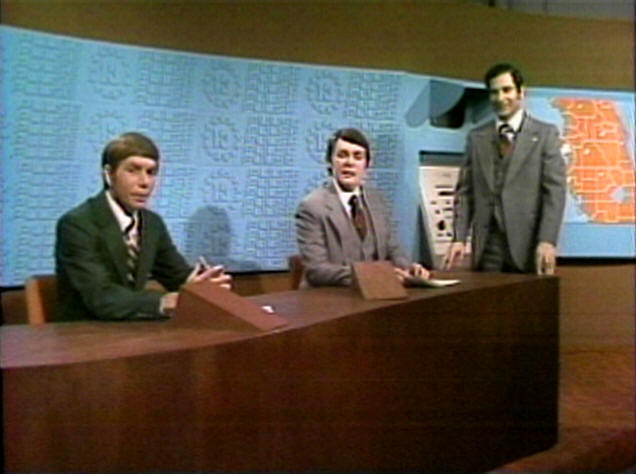
A wooden anchor desk and muted colors restore some dignity to the Pulse set in
1978.
Note the bicentennial "Original 13" vacuform background installed in 1976.
(L to R) Andy Hardy, John Nicholson, Roy Leep
By 1980 Herb's set had served it’s time and was replaced by a smaller, more angular construction with a laminated anchor desk. The 1980 set, with it's mustard-yellow color and sharp (yet dullish) lines, was no match for Herb's design. In 1984 news was moved permanently to Studio B and a larger, more attractive set was supplied by an outside firm specializing in local news design.
 |
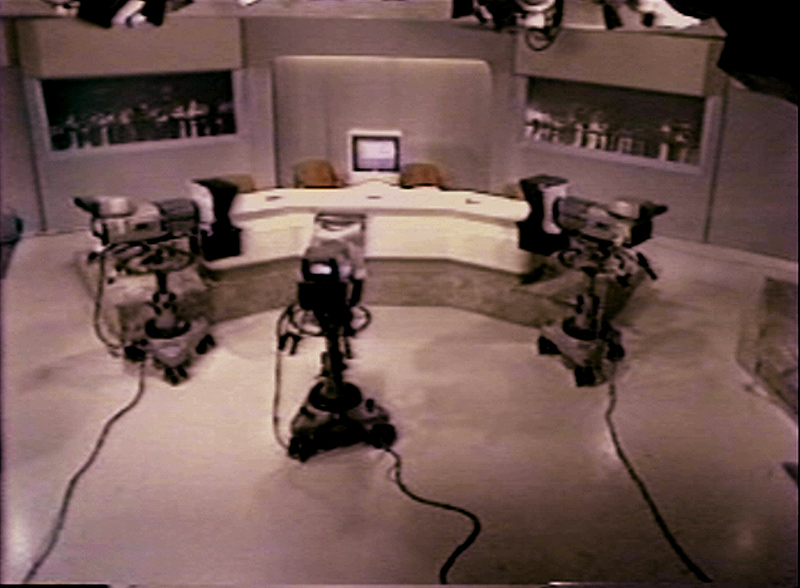 |
(LEFT) Jim West anchors from the 1980 Pulse set (Right) In 1984 the PULSE set was located in Studio B
In the meantime Herb's business, renamed Design Line, grew to eventually become the prime vendor of major facilities over the entire southeast. His work included major installations at Disney Magic Kingdom, EPCOT, Sea World, and Tampa Theatre. In 1988 Herb joined the faculty of the USF School of Architecture where he developed and taught one of the first courses in utilizing computers for architectural design. Over the next 10 years he designed and constructed large projects in Tokyo and Sao Paulo. Herb is now retired with his wife in Ocala, where they operate a horse boarding and training business on their own 10 acre spread.
In looking back to Herb Schmoll’s 1971 PULSE set, BIG 13 feels that he deserves kudos for a practical yet appealing television design that holds up well. Herb took wood, plaster, plastic and Elmer's Glue to create one of the best local news sets. And what better accolade can you give an artist but to say “your work is timeless?”